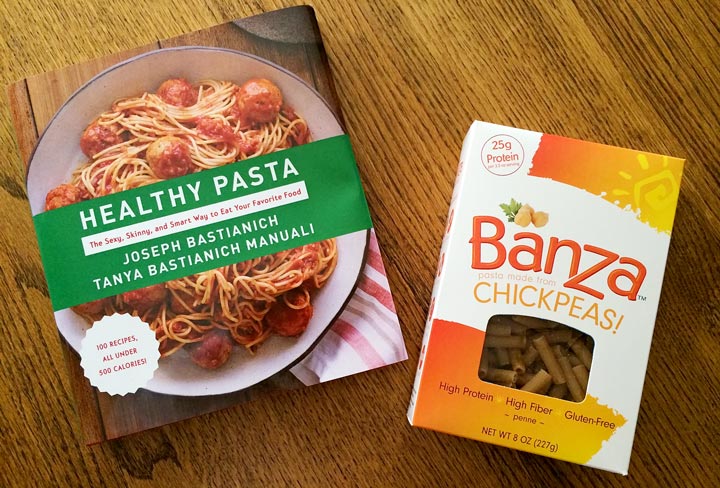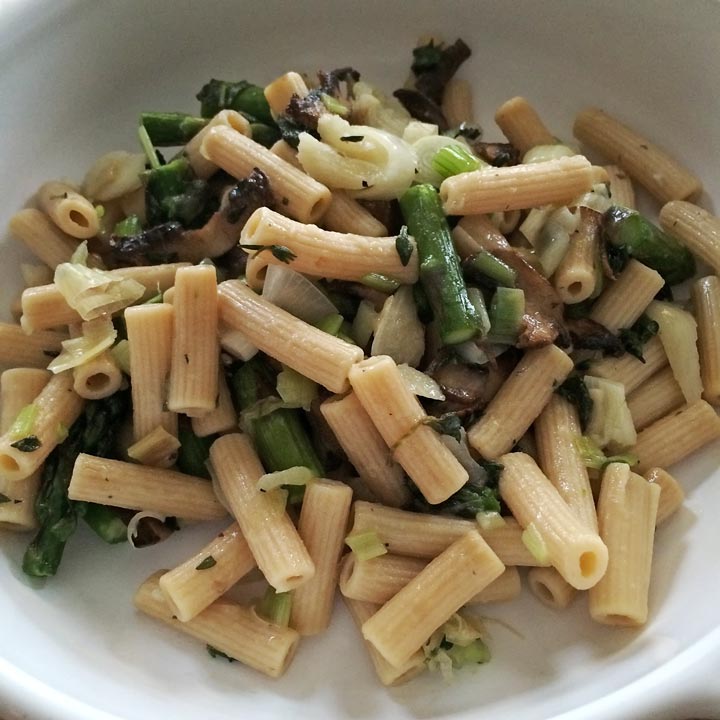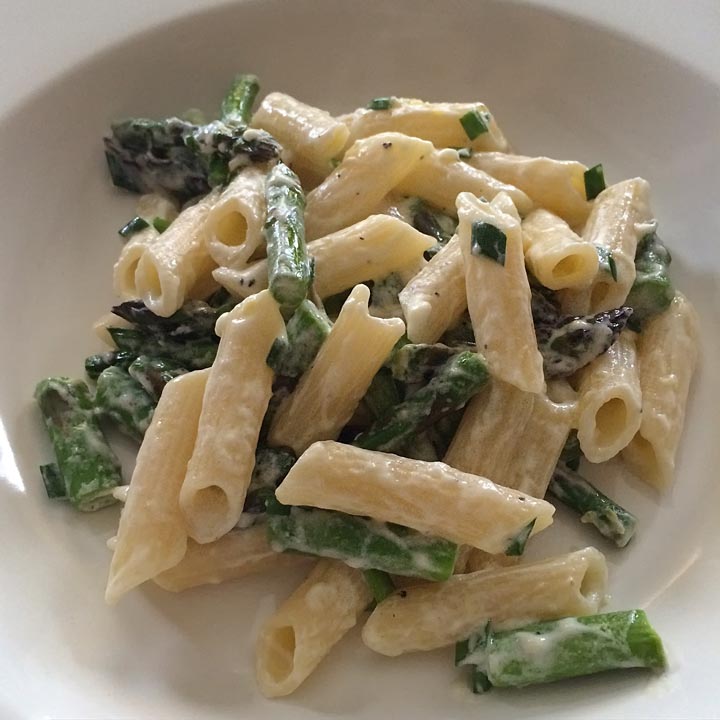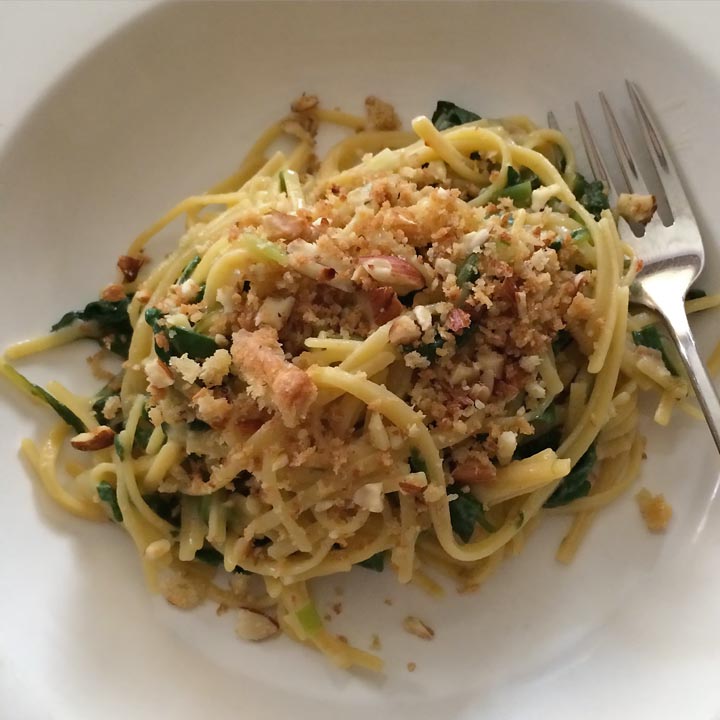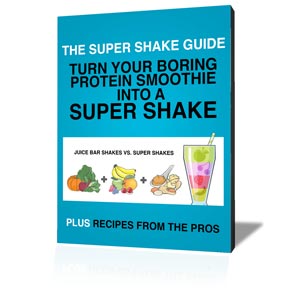I will never tell you that zoodles actually taste like pasta. Zoodles taste good but you have to accept them for what they are and judge them as such. Sometimes they will hit the spot. Sometimes nothing will do but the real thing.
Yes, you can have pasta. Yes, it can be healthy. Even if it is gluten free it can taste good.
Carbs like pasta are all about timing and portion. If fat loss is your goal, try to keep the pasta (and other starchier carbs like bread and rice) after exercise or physical activity. Your body is better able to use them. It also needs to be a reasonable portion. A two ounce serving (the common serving size on a box of pasta) is probably much smaller than the portion most people serve themselves or you see on a restaurant plate. The pasta should be “bulked up” with vegetables and accented with protein to create a balanced plate.
These are the same ideas about making pasta healthy that I heard on a recent NPR interview with Joe Bastianich and Tanya Bastianich Manuali about their book entitled Healthy Pasta. The son and daughter of Lidia Bastianich, the Italian chef and much loved host of Lidia’s Kitchen, should know a thing or two about pasta. Combining their proud heritage and their extensive knowledge, the have put together a book of over 100 pasta recipes that are under 500 calories. Here is a brief description from their publisher’s web site:
Do not be fooled: this is not a diet book. There are no tricks and no punishing regimens—it is just a simple guide to enjoying more of the food you love in ways that are good for you. Using ingredients and cooking methods that maximize taste but minimize fat content, Joe and Tanya will teach you what different grains mean to your diet, how to pair particular grains with sauces, why better-quality pasta is healthier for you, the health benefits of cooking pasta al dente, and how to reduce fat and calories in your sauces.
Always happy to try out new recipes, and excited by the tips in the interview, I ordered a copy of the book. I don’t cook pasta often much to the dismay of my Italian cuisine loving husband. Most of the pasta dishes we used to make are either loaded with cheese or lack protein and vegetables. (Baked Ziti with Chickpeas from Vegetarian Times and Mushroom Bolognese from Clean Eating Magazine are two notable vegan exceptions.) The book gave me the perfect reason to try to bring pasta back into our regular rotation and take advantage of the fresh crop of mushrooms, asparagus and herbs at the farmers market.
In addition to ordering the book, I also looked up the gluten free pasta they mentioned by name in the interview, Banza. Banza is a chickpea flour pasta boasting 14 g of protein and 8 g of fiber per serving! That makes it a smarter choice for everyone, in my opinion. Protein and fiber help slow down digestion, which helps slow down the release of the carbs (as glucose) into the body and keeps you feeling fuller longer. Banza isn’t available in my area so I contacted the company and they graciously sent me a few sample boxes (I was not paid or asked to write a review, the options in this article are all mine). The pasta and the book arrived within days of each other and I settled in one night to read the book and pick my selections.
Don’t skip the introduction to Healthy Pasta. There is a lot of information in the first few pages on how to make any pasta recipe a little bit better for you. In addition to the addition of vegetables and portion control, they talk about how to use the pasta water for sauce and substitutions for heavy cream and cheese. There is also a great discussion of different types of gluten free pastas, including a recipe to make your own at home.
I wasn’t going to be that adventurous, but I may have spent a little more time on a recipe or two than I might normally allow. It was worth it. Here are the three recipes I’ve whipped up so far.
Mostaccioli with Asparagus and Roasted Mushrooms (pg 28)
I substituted the Banza penne for the mostaccioli and made a half batch since I was home alone. I am often guilty of subbing dried herbs for fresh but I am learning how much of a flavor difference it makes. Fresh sage and thyme made this dish delicious! The Banza pasta was amazing cooked al dente and made the dish very filling . While Brian said he could taste the difference (he had the leftovers), it tasted very much like whole wheat pasta to me. Huge thumbs up for Banza!
Penne with Asparagus and Goat Cheese (pg 44)
Brian said this was “like spring exploded my mouth”. It was bright, light and flavorful. I took down the amount of goat cheese and left out the Grana Padano cheese and, to me, it made it no less amazing. If I am going to splurge, I also go with the best quality cheese I can get. In this case it was Terrell Creek Farms Chevre from the farmers market. So creamy and smooth, it melted in my mouth. It reminded me of the chevre we had in Paris.
Linguine with Spinach and Lemon (pg 36)
So simple and so full of flavor. The crushed red pepper brings a spicy zing to this dish, making it Brian’s favorite (and perhaps mine too) of the three recipes I’ve tried so far. This recipe shows you how to finish the dish with a cheese alternative instead of Parmesan, making it an easy vegan meal. I used gluten free bread and Aztec Quinoa Corn Linguine to also make this dish gluten free.
I love how this book helps you learn re-frame pasta as an accent, rather than the main event. I helps reinforces that a healthy lifestyle is not about living without your favorite foods. Pasta can be part of a healthy diet no matter what our goals are. I am just getting started with the new pasta possibilities for my own menu. I think Brian is really glad to hear that.

